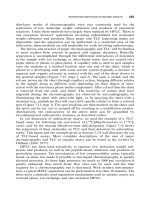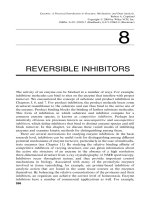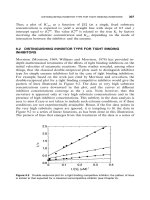Addison wesley CMMI distilled a practical introduction to integrated process improvement 3rd edition may 2008 ISBN 0321461088
Bạn đang xem bản rút gọn của tài liệu. Xem và tải ngay bản đầy đủ của tài liệu tại đây (4.32 MB, 501 trang )
CMMI®Distilled:APracticalIntroductiontoIntegrated
ProcessImprovement,ThirdEdition
byDennisM.Ahern;AaronClouse;RichardTurner
Publisher:AddisonWesleyProfessional
PubDate:May02,2008
PrintISBN-10:0-321-46108-8
PrintISBN-13:978-0-321-46108-7
eTextISBN-10:0-321-56427-8
eTextISBN-13:978-0-321-56427-6
Pages:288
TableofContents|Index
Overview
CMMI®(CapabilityMaturityModel®Integration)isanintegrated,
extensibleframeworkforimprovingprocesscapabilityandqualityacross
anorganization.Ithasbecomeacornerstoneintheimplementationof
continuousimprovementforbothindustryandgovernmentsaroundthe
world.Richinbothdetailandguidanceforawidesetoforganizational
domains,theCMMIProductSuitecontinuestoevolveandexpand.
UpdatedforCMMIVersion1.2,thisthirdeditionofCMMI®Distilled
againprovidesaconciseandreadableintroductiontothemodel,aswell
asstraightforward,no-nonsenseinformationonintegrated,continuous
processimprovement.Thebooknowalsoincludespracticaladviceon
howtouseCMMIintandemwithotherapproaches,includingSixSigma
andLean,aswellasnewandexpandedguidanceonpreparingfor,
managing,andusingappraisals.
Writtensothatreadersunfamiliarwithmodel-basedprocess
improvementwillunderstandhowtogetstartedwithCMMI,thebook
offersinsightsforthosemoreexperiencedaswell.Itcanhelpbattlescarredprocessimprovementveterans,andexperiencedsuppliersand
acquirersofbothsystemsandservices,performmoreeffectively.CMMI®
Distilledisespeciallyappropriateforexecutivesandmanagerswho
needtounderstandwhycontinuousimprovementisvaluable,whyCMMI
isatoolofchoice,andhowtomaximizethereturnontheireffortsand
investments.Engineersofallkinds(systems,hardware,software,and
quality,aswellasacquisitionpersonnelandserviceproviders)willfind
ideasonhowtoperformbetter.
Thethreeauthors,allinvolvedwithCMMIsinceitsinception,bringa
wealthofexperienceandknowledgetothisbook.Theyhighlightthe
pitfallsandshortcutsthatarealltoooftenlearnedbycostlyexperience,
andtheyprovideacontextforunderstandingwhytheuseofCMMI
continuestogrowaroundtheworld.
CMMI®Distilled:APracticalIntroductiontoIntegrated
ProcessImprovement,ThirdEdition
byDennisM.Ahern;AaronClouse;RichardTurner
Publisher:AddisonWesleyProfessional
PubDate:May02,2008
PrintISBN-10:0-321-46108-8
PrintISBN-13:978-0-321-46108-7
eTextISBN-10:0-321-56427-8
eTextISBN-13:978-0-321-56427-6
Pages:288
TableofContents|Index
Copyright
ListofFigures
Preface
PartI:IntegratedProcessImprovement
Chapter1.WhyIntegratedProcessImprovement?
Section1.1.BusinessObjectivesandProcessImprovement
Section1.2.TheEngineeringEnvironmentoftheTwenty-First
Century
Section1.3.EvolvingEngineeringApproaches
Section1.4.AProliferationofModelsandStandards
Section1.5.TheBenefitsofIntegratedProcessImprovement
Section1.6.Conclusions
Chapter2.ImplementingContinuousImprovement
Section2.1.DrivingBusinessPerformance
Section2.2.ElementsofContinuousImprovement
Section2.3.FiveKeysforContinuousImprovement
Section2.4.ManagementofContinuousImprovementActivities
Section2.5.EveryoneUnderstandsandParticipates
Section2.6.PearlsofWisdom
PartII:TheCMMIModels
Chapter3.TheCMMIConcept
Section3.1.AnOverviewofCMMI
Section3.2.CMMIObjectives
Section3.3.TheThreeSourceModels
Section3.4.CMMIProjectOrganization
Chapter4.CMMIContent
Section4.1.Constellations
Section4.2.ProcessAreas
Section4.3.ContentClassification
Section4.4.RequiredMaterials
Section4.5.ExpectedMaterials
Section4.6.InformativeMaterials
Section4.7.Additions
Section4.8.CMMIModelFoundation
Section4.9.DocumentMap
Chapter5.CMMIRepresentations
Section5.1.StagedModels
Section5.2.ContinuousModels
Section5.3.CMMIModelRepresentations
Section5.4.Conclusion
Chapter6.CMMIDimensionsforMeasuringImprovement
Section6.1.CapabilityDimension
Section6.2.MaturityDimension
Section6.3.GenericPracticesintheCapabilityDimension
Section6.4.GenericPracticesintheMaturityDimension
Section6.5.OrganizationalCapabilityEvolution
Chapter7.CMMIProcessAreas
Section7.1.FoundationProcessAreas
Section7.2.DevelopmentConstellation
Section7.3.AcquisitionConstellationProcessAreas
Section7.4.ServicesConstellationProcessAreas
Section7.5.RelationshipswithinCMMIComponents
PartIII:UsingCMMI
Chapter8.PickingaRepresentation
Section8.1.ReasonsforLikingStagedModels
Section8.2.ReasonsforLikingContinuousModels
Section8.3.ReasonsforChoosingaCMMIRepresentation
Chapter9.AppraisalswithCMMI
Section9.1.AppraisalRequirementsforCMMI
Section9.2.StandardCMMIAppraisalMethodforProcess
Improvement:ClassA
Section9.3.TheRoleofAppraisalsinContinuousImprovement
PartIV:TheFutureofCMMI
Chapter10.EvolvingCMMI
Section10.1.SimplifyingtheModel
Section10.2.ADomain-IndependentCMMIModel
Section10.3.CollectionofIssuesforBeyondVersion2.1
Section10.4.AFinalNoteonCMMIEvolution
Afterword
ThreeSelectionsfrom"AProcessImprovementSongbook"
Section1.CMMI(NorwegianWood)
Section2.TheTeamThat'sLevelOne(TheHouseoftheRising
Sun)
Section3.ICan'tHelpPeerReviewingYou(ICan'tHelpFallingin
LovewithYou)
AppendixA.SummaryofCMMIModels
CMMIModelFoundation
GenericGoalsandGenericPractices
DevelopmentConstellation
AcquisitionConstellation
ServicesConstellation
ServiceEstablishmentandDelivery
AppendixB.References
SEIFigureCreditList
Index
Copyright
TheSEISeriesinSoftwareEngineering
Manyofthedesignationsusedbymanufacturersandsellersto
distinguishtheirproductsareclaimedastrademarks.Wherethose
designationsappearinthisbook,andthepublisherwasawareofa
trademarkclaim,thedesignationshavebeenprintedwithinitialcapital
lettersorinallcapitals.
CMM,CMMI,CapabilityMaturityModel,CapabilityMaturityModeling,
CarnegieMellon,CERT,andCERTCoordinationCenterareregisteredin
theU.S.PatentandTrademarkOfficebyCarnegieMellonUniversity.
ATAM;ArchitectureTradeoffAnalysisMethod;CMMIntegration;COTS
Usage-RiskEvaluation;CURE;EPIC;EvolutionaryProcessfor
IntegratingCOTSBasedSystems;FrameworkforSoftwareProductLine
Practice;IDEAL;InterimProfile;OAR;OCTAVE;OperationallyCritical
Threat,Asset,andVulnerabilityEvaluation;OptionsAnalysisfor
Reengineering;PersonalSoftwareProcess;PLTP;ProductLine
TechnicalProbe;PSP;SCAMPI;SCAMPILeadAppraiser;SCAMPILead
Assessor;SCE;SEI;SEPG;TeamSoftwareProcess;andTSPare
servicemarksofCarnegieMellonUniversity.
SpecialpermissiontoreproduceinthisbookportionsofCMU/SEI-2006TR-008,CMMIforDevelopment,Version1.2,Copyright2006by
CarnegieMellonUniversity,portionsofCMU/SEI-2007-TR-017,CMMIfor
Acquisition,Version1.2,Copyright2007byCarnegieMellonUniversity,
andselectedfiguresfromIntroductiontoCMMIVersion1.2,Copyright
2006byCarnegieMellonUniversity,isgrantedbytheSoftware
EngineeringInstitute.
SEIFigureCreditListappearsonpage249.
Theauthorsandpublisherhavetakencareinthepreparationofthis
book,butmakenoexpressedorimpliedwarrantyofanykindand
assumenoresponsibilityforerrorsoromissions.Noliabilityisassumed
forincidentalorconsequentialdamagesinconnectionwithorarisingout
oftheuseoftheinformationorprogramscontainedherein.
Thepublisheroffersexcellentdiscountsonthisbookwhenorderedin
quantityforbulkpurchasesorspecialsales,whichmayincludeelectronic
versionsand/orcustomcoversandcontentparticulartoyourbusiness,
traininggoals,marketingfocus,andbrandinginterests.Formore
information,pleasecontact:U.S.CorporateandGovernmentSales,
(800)382-3419,
ForsalesoutsidetheU.S.,pleasecontact:InternationalSales,
VisitusontheWeb:informit.com/aw
LibraryofCongressCataloging-in-PublicationData
Ahern,DennisM.
CMMIdistilled:apracticalintroductiontointegratedprocess
improvement/
DennisM.Ahern,AaronClouse,RichardTurner.—3rded.
p.cm.
Includesbibliographicalreferencesandindex.
ISBN978-0-321-46108-7(pbk.:alk.paper)
1.Capabilitymaturitymodel(Computersoftware)I.Clouse,Aaron.II.
Turner,
Richard,1954-III.Title.
QA76.758.A3972008
005.1068'5—dc222008008198
Copyright©2008PearsonEducation,Inc.
Allrightsreserved.PrintedintheUnitedStatesofAmerica.This
publicationisprotectedbycopyright,andpermissionmustbeobtained
fromthepublisherpriortoanyprohibitedreproduction,storageina
retrievalsystem,ortransmissioninanyformorbyanymeans,electronic,
mechanical,photocopying,recording,orlikewise.Forinformation
regardingpermissions,writeto:
PearsonEducation,Inc.
RightsandContractsDepartment
501BoylstonStreet,Suite900
Boston,MA02116
Fax:(617)671-3447
ISBN-13:978-0-321-46108-7
TextprintedintheUnitedStatesonrecycledpaperatCourierin
Stoughton,Massachusetts.
Firstprinting,April2008
ListofFigures
Figure
2-1
Fivekeysforcontinuousimprovement
33
Figure
2-2
TheSixSigmaDMAICmethod
40
Figure
3-1
TheCMMIconcept
59
Figure
3-2
CurrentCMMIprojectorganization
67
Figure
4-1
Documentmapforthemodel
82
Figure
5-1
Capabilitylevelprofile(simple)
86
Figure
5-2
Targetprofile2
93
Figure
5-3
Targetprofile3
93
Figure
5-4
Targetprofile4
94
Figure
5-5
Targetprofile5
95
Figure
6-1
Capabilitydimension
99
Figure
6-2
Buildingcapability
101
Figure
6-3
Stagedmaturitylevels
103
Figure
6-4
Maturitylevelstructure
104
Figure
ProcessManagementprocessarearelationships
119
7-1
Figure
7-2
OrganizationalProcessDefinitioncontext
diagram
120
Figure
7-3
OrganizationalProcessFocuscontextdiagram
122
Figure
7-4
OrganizationalProcessPerformancecontext
diagram
124
Figure
7-5
OrganizationalInnovationandDeployment
contextdiagram
125
Figure
7-6
OrganizationalTrainingcontextdiagram
127
Figure
7-7
ProjectManagementprocessarearelationships
128
Figure
7-8
ProjectPlanningcontextdiagram
129
Figure
7-9
ProjectMonitoringandControlcontextdiagram 130
Figure
7-10
IntegratedProjectManagement(withoutIPPD)
contextdiagram
Figure
7-11
IntegratedProjectManagementforIPPDcontext 132
diagram
Figure
7-12
QuantitativeProjectManagementcontext
diagram
133
Figure
7-13
RiskManagementcontextdiagram
135
Figure
7-14
RequirementsManagementcontextdiagram
136
Figure
7-15
ConfigurationManagementcontextdiagram
138
Figure
7-16
ProcessandProductQualityAssurancecontext
diagram
139
131
Figure
7-17
MeasurementandAnalysiscontextdiagram
140
Figure
7-18
DecisionAnalysisandResolutioncontext
diagram
141
Figure
7-19
CausalAnalysisandResolutioncontextdiagram 143
Figure
7-20
RequirementsDevelopmentcontextdiagram
145
Figure
7-21
TechnicalSolutioncontextdiagram
147
Figure
7-22
ProductIntegrationcontextdiagram
148
Figure
7-23
Verificationcontextdiagram
150
Figure
7-24
Validationcontextdiagram
151
Figure
7-25
SupplierAgreementManagementcontext
diagram
152
Figure
7-26
AgreementManagementcontextdiagram
155
Figure
7-27
AcquisitionRequirementsDevelopmentcontext 156
diagram
Figure
7-28
AcquisitionTechnicalManagementcontext
diagram
157
Figure
7-29
AcquisitionValidationcontextdiagram
158
Figure
7-30
AcquisitionVerificationcontextdiagram
158
Figure
7-31
SolicitationandSupplierAgreement
Developmentcontextdiagram
160
Preface
CMMIDistilledwasoriginallyconceivedasawaytointroducetheCMMI
ProductSuiteandmodel-basedcontinuousprocessimprovementtoa
wideaudience.Ourgoalwastoofferasuccinct,no-nonsense,minimaljargon,wittilywritten,practicalguidethatwaslessthanhalftheweightof
the"official"CMMIbook.Wewantedtodescribetheoriginsofthemodel
andgivethereaderssomeinsightintohowthe200-plusCMMIauthors
worked(andfought)toproduceit.Thefirsteditionhadagooddealof
"why"information,aimedatfolkswhohadusedoneofthethreesource
modelsandwhowantedtounderstandhowCMMIdifferedfromearlier
models.Ofcourse,italsohadthe"what"and"how"informationabout
CMMIVersion1.0.
Thesecondeditioncoincided(roughly)withthereleaseofCMMIVersion
1.1,soitincludedsignificantchangestotheoriginal"what"and"how"
sections.AtthatpointCMMIwasnolongernewandpeoplewere
beginningtomoveawayfromthesourcemodels,soweremovedsome
ofthe"why"material.ToreflectthebroaderreachofCMMIandtheneed
tosupportpractitionersinacquiringsponsorsfortheirimprovement
initiatives,thesecondeditionaddedmaterialaimedatmanagersrather
thanpractitioners.
CMMIcontentandusagecontinuetoevolve,sonowwehavecreateda
thirdedition,buildingonthelegacyofthefirsttwo.CMMIbeganasatool
formanagingimprovementsinengineeringdevelopmentorganizations,
withafocusonsystemsandsoftware.InCMMIVersion1.2,thisattention
toengineeringhasbeenstrengthenedbyincludingexplicithardwarerelatedinformation.Moreintriguing,however,aretwonewmembersof
theCMMIProductSuite:onefortheacquirerofsystemsinsteadofthe
developer,andtheotherforserviceprovidersinsteadofproductbuilders.
Withthesetwoadditions,thepotentialscopeofapplicationforCMMI
withinanorganizationalenterprisehasbroadenedsignificantly.Atthe
sametime,CMMIisfindinguseoutsidethetraditionalengineeringfield.
Forexample,ithasbeenadoptedbyenterprisesasvariedasmedical
facilitiesseekingtoimprovetheirpatientcareandgovernmententities
tryingtobuildandimprovetheirinfrastructure.
WehadthreeprimaryreasonsforwritingthethirdeditionofCMMI
Distilled.
1. WewantedtoupdatethebooktoincludechangestotheCMMI
architecture,content,andpresentation,aswellastheongoing
domainextensionstothemodel.Thefull,updatedmodelcontentfor
version1.2iscoveredinthesamewayasinourpreviouseditions.
WeusethegraphicsfromtheCMMItrainingmaterialanddescribe
themodelcomponentsclearlyandsimply.
2. Wewantedtofurtherreducetheamountofhistoricalinformation
relatingtotheoriginsofCMMI.Forthosewhomaybeinterested,
thismaterialiswellcoveredinthepreviouseditionsofthisbook.
3. Wewantedtoupdateandexpanduponthepracticaladviceweoffer
forthoseusingthemodel.Inthisedition,wemorefullyaddress
CMMIusageintandemwithSixSigma,leanengineering,andother
continuousimprovementapproaches.Wealsodiscusssomeofthe
changestotheappraisalmethods;specifically,weprovideadditional
guidanceonpreparingforandmanagingappraisals,andonusing
theappraisalresultsasapowerfulinputtoimprovementactivities.
Thosewhohavereadthepreviouseditionsofthisbookwillnotbe
surprisedtofindthatwehaveincludedyetanotherliteraryoffering(three
songs)addressingCMMIandtheworldofcontinuousimprovement.In
fact,forthoseofyouwhomayhavemissedthefirsttwoeditions,the
earlier"literarygems"canbefoundonthePearsonWebsiteat
informit.com/awundereither"literarygems"or"superfluousmaterial"—
forsomereason,theeditorswerestilldiscussingthisasofpublication.
Andso,inrecognitionoftheexplosivegrowthofCMMIasaprocess
improvementtoolofchoicearoundtheworld,andhavingincorporated
themostrecentdevelopmentsintheevolutionofthemodelsuite,weare
pleasedandexcitedtopresentthisthirdeditionofCMMIDistilled.We
hopethatitwillcontinuetohelpourreadersunderstandtheCMMI
ProductSuiteanduseitwiselyfortheircontinuousimprovement
initiatives.
Asalways,wecouldn'thaveputthisthirdeditiontogetherwithoutthe
support,wisdom,andpatienceofourwonderfulwives.Pam,Debbi,and
Jo—westillloveyouthebestofall!
Dennis,Aaron,andRich
April2008
PartI:IntegratedProcessImprovement
TheTowerofBabelGustaveDore(1832–1883)
©2007JupiterImagesCorporation
InthebiblicalstoryoftheTowerofBabel,Godcausedaconstruction
projecttofailbyinterruptingcommunicationthroughthecreationof
multiplelanguages.Inthemodernstoryofprocessimprovement,we
havecreatedmultiplelanguagestoservevariousorganizational
disciplinesthroughdivergentprocessimprovementmodelsand
methods.AswiththeTowerofBabelstory,thisdiversityposesa
threattocommunication.CapabilityMaturityModelIntegration
(CMMI)andintegratedprocessimprovementingeneralstriveto
reversethissituationbyprovidingasinglelanguagethroughwhich
multipledisciplinescanshareprocessimprovementactivitiesanda
unifiedfocusonprocessimprovementobjectives.
PartIContents
Chapter1.WhyIntegratedProcessImprovement?
Inwhichthereaderisintroducedtotheconceptof,rationalefor,
andbenefitsderivedfromintegratedprocessimprovement.
Chapter2.ImplementingContinuousImprovement
Inwhichtheauthorstakeawide-ranginglookatthetoolsand
methodsavailabletosupportacultureofcontinuous
improvementthatmayhelpreadersmeettheirbusiness
objectives.
Chapter1.WhyIntegratedProcess
Improvement?
Itisnotnecessarytochange.Survivalisnotmandatory.
—W.EdwardsDeming(1900–1993)
Thecomplexityofpracticehasalwaysdwarfedthesimplicityof
theory.
—RobertBritcher,TheLimitsofSoftware(1999)
Giventhatyouarereading(oratleastbrowsingthrough)thisbook,either
youareinterestedincontinuousprocessimprovementandCapability
MaturityModelIntegration(CMMI),oryouhavebeentoldtoget
interestedinit.Perhapsyourmanagementchainoramajorcustomer
hasindicatedthatyourorganizationshouldbeatleastCMMI"level3."
Youthink:"ShouldIreallybeinterested?Willitmakeiteasierformeto
domyjob?Whatislevel3?WhatisCMMI?"Thisbookwillhelpyou
answerthesequestions.
Chapter1reviewsthebusinesscontextforanyimprovementinitiative,
explainingwhythatmanagerorcustomermaybeencouragingyouto
undertakesuchaninitiative.Tounderstandtherationaleforchange,it's
importanttolookatsomeshortcomingsoftraditionalprocess
improvementwhenfacedwiththeengineeringparadigmofthetwentyfirstcentury.Theengineeringworldhaschangedinatleastthree
significantareassincetheintroductionofmodel-basedprocess
improvement.
First,theenvironmentwithinwhichengineeringisperformedhasbecome
increasinglycomplex.Effortsarelarger,involvemorepeople,cross
corporateandinternationalboundaries,aredistributedfarandwide,and
mustadheretocontinuallycompressingimplementationschedulessoas
tomeetcustomerneedsandheightenedexpectations.
Second,thewayinwhichengineeringworkisperformedhasevolved.
Cross-disciplineteams,concurrentengineering,integrationof
commercialoff-the-shelf(COTS)andopen-sourcesoftwareratherthan
traditionalsoftwaredevelopment,agileandevolutionarydevelopment
approaches,highlyautomatedprocesses,andmultinationalstandards
arealltrendsthathaveaffectedengineeringpractice.Thesechanges,in
turn,haveinspiredmodificationsintheroleoftheengineeringmanager.
Third,thecontinuingproliferationofprocessimprovementmodels,
methods,andstandardshasincreasedthechallengeofdefiningand
managingprocessimprovementactivities.Organizationshaveadopted
multipleapproachestocontinuousimprovementtoaddresstheircritical
processes.
Allofthesetrendshighlighttheneedtointegrateprocessimprovement
efforts.Themyriaddisciplinesandprocessesinvolvedincontemporary
engineeringarecloselyintertwined.Unfortunately,theoverheadand
confusionresultingfromtheapplicationofmultiplemodelsandmethods
aretoocostlyintermsofbusinessexpensesandresourceallocation.As
aconsequence,ameansofaddressingprocessimprovementacrossa
numberofdisciplineswithinasingleframeworkisneeded.Thischapter
discusseshowchangesintheengineeringworldhaveinfluencedthe
effectivenessoftraditionalprocessimprovementstrategiesandexplores
howorganizationscanbenefitfromapplyinganintegratedapproachto
reachtheirbusinessobjectives.
Model-BasedProcessImprovement
Model-basedprocessimprovementinvolvestheuseofa
structuredframeworktoguidetheimprovementofan
organization'sprocesses.Processimprovementgrewoutofthe
qualitymanagementworkofDeming,[1]Crosby,[2]andJuran[3]
andisaimedatincreasingthecapabilityofworkprocesses.
Essentially,processcapabilityistheinherentabilityofaprocess
toproduceplannedresults.Asthecapabilityofaprocess
increases,itbecomespredictableandmeasurable,andthemost
significantcausesofpoorqualityandproductivityarecontrolled
oreliminated.Bysteadilyimprovingitsprocesscapability,the
organization"matures."Maturityimprovementrequiresstrong
managementsupportandaconsistentlong-termfocus.In
addition,itnecessitatesfundamentalchangesintheway
managersandpractitionersperformtheirjobs.
Oneframeworkforachievingthisfocushasbeentheuseofa
capabilitymodel.Modelsprovideacommonsetofprocess
requirementsthatcapturesuccessfulpracticesandpractical
knowledgeinaformatthatcanbeusedasaguideinsetting
priorities.Byusingamodel,organizationscanmodifyorcreate
processesbyincorporatingpracticesthathavebeenprovento
increaseprocesscapability.Theymayalsoemploymodelsto
conductanappraisalofprocesscapabilityfortwopurposes:to
establishabaselineforimprovementandtomeasureprogress
asimprovementactivitiesproceed.
Generally,model-basedprocessimprovementbeginswith
managementcommitmentandanappraisaloftheorganization's
existingprocesses.Thefindingsfromthisappraisal,inturn,feed
actionplans.Whentheseplanshavebeencompleted,further
appraisalsareperformedandthecyclecontinues.Thegoalisfor
theorganizationtomaturesothatitcontinuouslymonitorsand
improvesitsprocesses,consistentlyproduceshigh-quality
products,isagilewithinitsmarketplace,andadjustsquicklyto
customerneeds.Foradiscussionofbothmodel-basedand
otherimprovementtechniques,seetheCMMISurvivalGuideby
GarciaandTurner.[4]
[1]Deming,W.Edwards.OutoftheCrisis.Cambridge,MA:MITCenterforAdvanced
Engineering,1986.
[2]Crosby,P.B.QualityIsFree.NewYork:McGraw-Hill,1979.
[3]
Juran,J.M.JuranonPlanningforQuality.NewYork:MacMillan,1988.
[4]Garcia,Suzanne,andRichardTurner.CMMISurvivalGuide:JustEnoughProcess
Improvement,Boston:Addison-Wesley,2007.
1.1.BusinessObjectivesandProcess
Improvement
First,let'stalkaboutyourorganizationandhowyouoryourmanagement
mightlikeittoperform.Organizationsgenerallyhavemanydifferent
businessobjectives:
Producequalityproductsorservices
Createvalueforthestockholders
Beanemployerofchoice
Enhancecustomersatisfaction
Increasemarketshare
Implementcostsavingsandsuccessfulpractices
Gainindustry-widerecognitionforexcellence
Toachieveastrongcompetitiveedgeinarapidlymovingmarketplace,
youmightliketoaggressivelytakeadvantageofopportunitiesandavoid
simplyreactingtochange.Youmightalsoliketoimproveyourabilityto
predictcostsandrevenues,findwaystoraiseproductivity,and
implementmeanstolowerexpenses.Thesemeasurescouldhelpyouto
anticipateproblems,anddevelopwaystoaddressthemearly.
Tomeetanyoftheseobjectives,youmusthaveaclearunderstandingof
whatittakestoproduceyourproductsorservices.Toimprove,youneed
tounderstandthevariabilityintheprocessesthatyoufollow,sothat
whenyouadjustthem,you'llknowwhethertheadjustmentis
advantageous.Inshort,you'llwanttomanageyourbusinessusing
accuratedataaboutbothproductsandprocesses.
Butwait:Howdoyouknowthatyourdataisreasonableoraccurate?
Canyoucompareinformationbetweenprojects?Generally,therehasto
besomeconsistencyintheworkyoudoifyouaretomakevalid
comparisons.Youwanttobeabletomeasureyoursuccessandmake
surethattheprocessesyoufollowaddvaluetotheproductsandservices
thatyouprovide.Ofcourse,thatimpliesastandardwayofdoingthings
andabaselineagainstwhichtomeasureyoursubsequentefforts.
Nowwearegettingdowntothenitty-gritty:Doesyourorganizationhave
experiencewithwritingandfollowingaprocess,andcanitsupportthe
developmentofcommon,standardprocesses?Canyoudeterminethe
bestwaystogoaboutaparticulartask?Establishingstandardprocesses
thatareappropriateandsuccessfulforyourworkplaceandbusinessis
fundamentalforprocesscontrolandimprovement.Unfortunately,itmay
notbewithinthescopeofyourpositiondescriptionsortraining.Andwhat
aboutthattraining?
Withoutgoodprojectmanagementandfundamentaltechnicalskills,
projectscannotoperateeffectivelyenoughtospendanytimeon
improvement.Basicactivitiessuchasplanningandtrackingneedtobe
understoodandencouraged.Versioncontrolandriskmanagementare
essentialdisciplinesthatneedtobeaddressed.Inaddition,managing
requirementssothatyoudelivervaluetoyourcustomerisakeybusiness
objective.
Asyoucanseefromtheprecedingdiscussion,gettingtothepointwhere
yourorganizationenjoysacompetitiveedgerequiresanumberof
incrementalimprovements.That'swhereprocessimprovementcanreally
help.Processimprovementactivitiesfocusonimprovingprocess
capability,organizationalmaturity,processefficiency,andprocesscontrol
soastohelpyouadvancetheorganizationandaccomplishitsobjectives.
Theycanprovideyouwithguidanceonhowtodocumentand
standardizeprocesses,increaseyourworkeffectiveness,limitrework,
measuretheperformanceoftheorganization,andusethedatato
managethebusiness.
Ofcourse,thereisacostassociatedwithprocessimprovement.
Experienceshowsthatitcantakebetween2percentand10percentof
normalengineeringefforttosupportasignificantprocessimprovement
initiative.Atthesametime,experiencealsoconfirmsthatprocess
improvementbringsasignificantlypositivereturnoninvestment(ROI)
andimprovementinkeybusinessindicators.Considerthese
representativeexamplesofCMMIsuccesses:
DBSystemsGmbHreportedthatitscostsdropped48percentfrom
abaselinepriortoSW-CMMmaturitylevel2astheorganization
movedtowardCMMImaturitylevel3.[5]
[5]Richter,Alfred,"QualityforITDevelopmentandITServiceOperations:CMMIand
ITILinaCommonQualityApproach."London:ESEPG,June16,2004.
AstheorganizationmovedfromSW-CMMmaturitylevel3toCMMI
maturitylevel5,IBMAustraliaApplicationManagementServices
sawitson-timedeliveryincreaseby10percent,itson-budget
deliveryimproveby41percent,customersatisfactionriseby33
percent,andapplicationdevelopmentproductivityimproveby76
percent,resultinginacumulativecostssavingsofAU$412millionto
thecompany'sclient.[6]
[6]Nichols,Robyn,andColinConnaughton,SoftwareProcessImprovementJourney:
IBMAustraliaApplicationManagementServices.AReportfromtheWinnerofthe
2004SoftwareProcessAchievementAward(CMU/SEI-2005-TR-002).Pittsburgh,PA:
SoftwareEngineeringInstitute,CarnegieMellonUniversity,2005.
NorthropGrummanITDefenseEnterpriseSolutions,aCMMI
maturitylevel5organizationwhoseengineershadundergone
PersonalSoftwareProcess(PSP)training,reducedidentifieddefects
from6.6to2.1perKLOCoverthreecausalanalysisandresolution
cycles.[7]
[7]Hollenbach,Craig,"QuantitativelyMeasuredProcessImprovementsatNorthrop
GrummanIT."Denver,CO:CMMIUserGroupandConference,November2003.
Reuters'schedulevariancedecreasedfromapproximately25
percentto15percentastheorganizationmovedfromCMMmaturity
level3toCMMImaturitylevel5.[8]
[8]Iredale,Paul,"The'InternalOffshore'ExperienceatReuters."Adelaide,Australia:
AustralianSEPG,September27–29,2004.
Astheseexamplesdemonstrate,processimprovementpromises
significantbenefitsfororganizations.Intheremainderofthischapter,we
showhowintegratingprocessimprovementacrossseveraldisciplines
canincreasethosebenefits.
ProcessImprovementandGolf
Ifyouhaven'tgotahandleonwhatprocessimprovementisand
howitcanhelpyourbusiness,here'sanonbusinesswaytothink
aboutit.Theprocessyouusetoproduceaproductorservice
maybelikenedtoagolfswing,inthatitisacomplexsequence
ofcloselycoupledactivitiesthatareperformedinanintegrated
mannertoachieveaspecificpurpose.Ofcourse,asweallknow,
improvingyourgolfswingisnotaneasytask.Neitheris
improvingyourbusinessprocesses.
First,it'simpossibletoaddressallfacetsofyourgolfswingat
once.Youneedtobreakitintopiecessoyoucanconcentrateon
makingadjustmentsthatareunderyourcontrol.Someofthose
pieces,suchasyourgripandyourstance(nottomentionthe
clublength,theflexibilityoftheshaft,thematerialintheclub
head,andsoon),arefundamentalsthathavetobeinplace
beforethereliabilityofanyoftheotherpiecescanbe
considered.Inotherwords,youhavetotakecareofthembefore
youcanmakesignificantprogressinotherareas.
Second,youcan'teasilytakeacriticallookatyourowngolf
swing.Youneedanobjectiveeye(thegolfprofessionalora
videocamera)thatcanhelpevaluatewhatisrightandwhatisn't.
Ofcourse,youalsoneedsomemeasuresofcorrectnesstouse
asaguideinmakingthesedeterminations.
Third,asyouimprovethecomponentsoftheswing(suchas
grip,stance,lengthofbackswing,andtempo),theybeginto
mergeintoamoreintegratedwholethatyoucanbeginto
"groove"intopredictableconsistency.Andonceyoufindthe
swingthat'scomfortablewithyour7iron,itthenneedstobe
applied(withappropriateadjustment)totheotherclubsinyour
bag.
Finally,it'sonlyafteryouhaveachievedconsistencyinyour
swingthatyoucanbegintomodifyitforthesituationathand
andreallyaddressthestrategicpartsofgolf—clubselection,
shotplacement,drawsandfades,andothernuancesthatmost
ofusseeonlyontelevision.
Inmanyrespects,organizationalprocessimprovementworksin
muchthesamewayasimprovingyourgolfswing.Modelsand
othercontinuousimprovementtechniquescanhelpyoubreak
yourprocessintopieces,showyouthefundamentals,andhelp
youdecidewhichaspectstoworkonfirst.Processimprovement
champions,groups,andconsultantscanhelpyouevaluateyour
currentprocessesandmeasureyourimprovement.The
standardprocessesthatyouemploycanprovideyouwith
standarddata,whichthenbecomesthebasisforyourprojectsto
"groove"theiractivitiessothatapplyingthemtonewareasand
thinkingstrategicallybecomenormalwaystowork.
Andbytheway,improvingyourorganizationmaybeeasierthan
improvingyourgolfswingbecauseyouhavealotoftalentthat
canworksynergistically,andtheydon'thavetodoitonlyon
weekends.Goget'em,Tiger.









